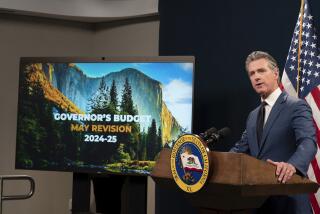Census Experts to Weigh In on Whether to Revise Total
How do you count 281 million Americans?
Very carefully.
The census process, which produced a down-to-the-last-person total of 281,421,906 Americans last April 1, looks like the ultimate work of precision from a distance.
Close up, it is a tangled skein of science and politics and one vital question: How good is the census and can it be made better by statistical adjustments?
Later this week, a group of career professionals at the Census Bureau will recommend whether or not to adjust last year’s count to get a better reflection of the “undercount”--the more than 3 million people who were overlooked. If they say the count should be changed, the Bush administration will have until Monday to decide which set of numbers--the original or the adjusted--should become the official census result.
No matter what happens, there will be unhappy people. Indeed, litigation is the only certainty surrounding the whole process. The city of Los Angeles, along with Inglewood, Santa Clara County, Stamford, Conn., and San Antonio already have sued, challenging the Bush administration’s decision to take the final decision-making power on adjustment out of the hands of the Census Bureau director. Utah has filed a separate lawsuit, claiming that it lost the chance to get an additional House seat because Mormons on overseas missions were not counted. Other census-related lawsuits already have been filed in Minnesota, Texas and Florida.
The Bush administration is likely to reject any adjustment in the census, arguing that the first count was the best. Political experts believe that any change from the original numbers gathered last year would help Democrats by adding to electoral districts increased numbers of blacks and Latinos, who are more likely to cast Democratic votes.
It is much more than an academic debate among statistical experts: The official census figures are used to help draw new district lines for thousands of political jurisdictions, ranging from seats in the House of Representatives to state legislatures, city councils and school boards. And the distribution of more than $200 billion a year in funds from Washington to state and local jurisdictions is determined by official census numbers.
Cities such as Los Angeles, with large minority populations, contend that ignoring the undercount would rob them of a fair share of the $200 billion a year in federal money. And organizations representing minority groups say that they would be deprived of a chance of getting fair political representation for their communities.
Ever since 1940, when more African American men registered for the draft than had been projected by the census to exist, experts have known that members of minority groups were more likely to be missed in the count.
To find out how many were overlooked, the government conducted a second mini-census last year, a survey of 314,000 households selected to reflect the nation’s demographic diversity. The Census Bureau used its best enumerators, the field workers who were most skilled and most persistent in getting answers from reluctant homeowners or renters. And they went back repeatedly.
Then the results of the second survey were compared with the first to measure the difference. The survey estimated both the undercount--when people are missed--and the overcount--when people are tallied twice.
Middle- and upper-income people have a better chance of being overcounted. Someone with a second, vacation home might get a census form at both addresses. Students living on college campuses may be counted at school as well as at the home of their parents.
By contrast, renters have a greater likelihood than homeowners of being overlooked. And members of minority groups have a lower rate of homeownership than whites.
While there might be some block-by-block errors, experts believe that an adjusted count is more accurate for an aggregate population across a county, state and then the nation.
“I don’t think any statistician would say it is necessarily the truth, but it is a better approximation of the truth,” said Kenneth Prewitt, the former census director who ran the 2000 count. “This really is rocket science. It’s not simple stuff.”
Dissenters argue that the adjustment can be unreliable.
At the basic, block level of the census, an adjustment is not necessarily any more accurate than the original census survey, said David Murray, research director of the Statistical Assessment Service, a nonprofit think tank and a Republican appointee to the Census Monitoring Board, a bipartisan group that helped oversee the 2000 census for accuracy.
The danger of an adjustment is that “you can put people in the wrong places and you can’t tell if they actually belong there,” he said.
More to Read
Get the L.A. Times Politics newsletter
Deeply reported insights into legislation, politics and policy from Sacramento, Washington and beyond. In your inbox three times per week.
You may occasionally receive promotional content from the Los Angeles Times.






